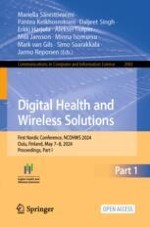1 Introduction
2 Related Work
2.1 Psychometric Tests
2.2 Medical Imaging
2.3 Biochemical Markers
Method | Invasive | Portable | Cost | Acc (%) |
|---|---|---|---|---|
Spinal Fluid Test | Yes | No | Medium | 80 |
MRI/CT/PET | No | No | High | 89 |
Blood Test | Yes | No | Medium | 93–95 |
2.4 Dementia Features and Modelling
3 Methodology
3.1 Dataset
3.2 Data Preprocessing
3.3 Feature Extraction
-
Statistics extracted included minimum, maximum, mean, range, standard deviation, energy, and autocorrelation. This set totals 133 features.
-
The metric used to capture the tighter grouping of signal pairs is Mean Absolute Difference (MAD). This was extracted for each unique pair of sensors. This set totals 171 features.
-
Hjorth Parameters extracted include Activity, Mobility and Complexity. This set totals 57 features.
-
In calculating power spectrum densities, total, mean, and relative power (the sum of a frequency band relative to the sum of the power spectrum) are extracted. This is done using the Welsch method of deriving the mean of a series of Fast Fourier Transforms (FFT) to leverage the computational gains of the FFT when dealing with nonstationary signals [26]. This set totals 255 features.
-
Cross Coherence is a statistical measure that measures the linear relationship between signal pairs at a specified frequency band [27]. This is calculated for each unique pair of sensors, at each frequency band. This set totals 855 features.
3.4 Initial Feature Selection
3.5 Modelling
3.6 Final Feature Selection and Optimisation
4 Results
4.1 Feature Selection and Benchmark Results
Data | Method | Features Selected | Error Count | Mean Error | Acc (%) |
|---|---|---|---|---|---|
Statistics | SVC | 6 | 6 | 0.31 | 66 |
MAD | SVC | 5 | 4 | 0.21 | 73 |
Hjorth | SVC | 13 | 5 | 0.26 | 75 |
PSD | SVC | 25 | 4 | 0.26 | 75 |
Coherence | KNN | 24 | 5 | 0.26 | 71 |
4.2 Initial Modelling Results
Method | Error Count | Mean Error | Acc (%) |
|---|---|---|---|
SEQ | 0.0 | 0.41 | 83 |
RNN | 2.0 | 0.24 | 84 |
LSTM | 0.0 | 0.09 | 91 |
LSTM Tuned | 0.0 | 0.09 | 95 |
4.3 Final Feature Selection
Features | Count | Error | Acc (%) |
|---|---|---|---|
O2_alpha_rel_power, coh_O1vsT6_theta | 0.0 | 0.305 | 98.1 |
coh_O1vsT6_theta, coh_O2vsF8_alpha | 0.0 | 0.25 | 97.3 |
coh_O1vsT6_theta, coh_O2vsF8_beta | 0.0 | 0.225 | 97 |
coh_C3vsT5_alpha, coh_O1vsT6_theta | 0.0 | 0.245 | 95.4 |
Pz_alpha_rel_power, coh_O1vsT6_theta | 0.0 | 0.3 | 95.2 |
Features | Count | Error | Acc (%) |
|---|---|---|---|
coh_O1vsT6_theta, coh_O2vsF8_alpha, coh_O2vsF8_beta | 0.0 | 0.190 | 97.5 |
coh_O1vsT6_theta, coh_O2vsF8_beta, coh_Fp1vsF3_delta | 0.0 | 0.185 | 96.4 |
coh_O1vsT6_theta, coh_O2vsF8_beta, O2_delta_rel_power | 0.0 | 0.205 | 96.3 |
coh_O1vsT6_theta, coh_O2vsF8_beta, coh_F3vsF8_delta | 0.0 | 0.195 | 96.3 |
coh_O1vsT6_theta, coh_O2vsF8_beta, coh_O2vsT4_beta | 0.0 | 0.210 | 96.3 |
Model/Label | Sensors | Inference (s) | Size (KB) | Acc (%) |
|---|---|---|---|---|
AD Model | ||||
Standard | 3 | 1.53 | 1,517 | 98.1 |
Lite | 3 | 0.34 | 18 | 98.1 |
AD-FTD Model | ||||
Standard | 4 | 1.09 | 1,536 | 98.5 |
Lite | 4 | 0.37 | 19 | 98.5 |
4.4 Inference and Architecture
Parameter | AD Model | AD-FTD Model |
|---|---|---|
Learning Rate | 0.0005 | 0.001 |
Optimiser | Adam | Adam |
Epochs | 18 | 15 |
Shape | [2,4] | [3] |
Batch Size | 16 | 32 |
Activation | Elu | Elu |
Times Step | 16 | 32 |
5 Discussion
Authors | Label | Electrodes | Method | Acc (%) |
|---|---|---|---|---|
Tavares, G. et al. (2019) | AD | 13 | LR/SVM | 97.1 |
Alessandrini, M. et al. (2022) | AD | 16 | LSTM | 97.9 |
Puri. et al.(2022) | AD | 6 | SVM | 97.5 |
This Research | AD | 3 | LSTM | 98.1 |
This Research | AD-FTD | 4 | LSTM | 98.5 |
